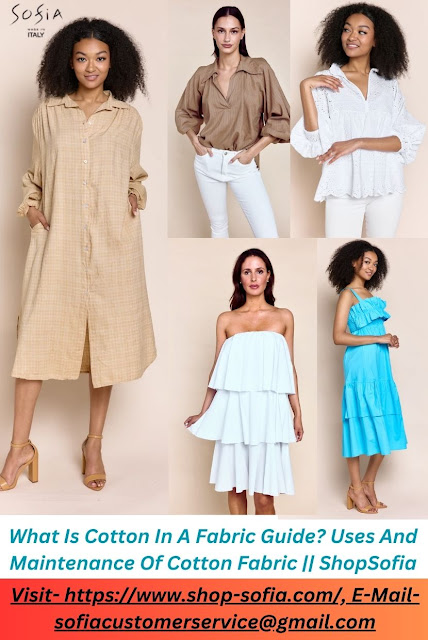What Is Cotton In A Fabric Guide? Uses And Maintenance Of Cotton Fabric || ShopSofia
The most popular fabric in the world is cotton. It is a natural fibre that has been raised for a very long time. Cotton plant seeds that have been washed, crushed, and spun into thread are used to make them. After being woven into cloth on a loom, the fibres are then sewn together to create clothing. Cotton is one of the most essential textiles in our life since it is versatile and requires little maintenance. The durability and adaptability of cotton fabric are key factors. It has been utilised as a source for garments, sheets, blankets, rugs, and more ever since the beginning of time.
In general, what is cotton?
Natural cotton fibre is spun into thread. It may be spun into yarn and garments may be woven from it. Although cotton has existed since the dawn of time, it wasn't until the 1800s that it started to be used more frequently in clothes in North America and Europe. Cotton fibres are the perfect fabric to utilise in textiles since they are supple, light, absorbent, and chemically resistant. Usually, it is grown in hot, humid climates with high humidity.
Various Cotton Fabric Types
Depending on the type of yarn used in their construction, various cotton fabric types exist. Cotton is biodegradable and organic. It may be woven into many other fabrics, such as cotton, linen, and canvas. These are the three primary categories of cotton materials, and we use them in a variety of ways throughout our daily lives. Various cotton fabric types include: Cotton-blend textiles, Cotton, Cotton fabric, Denim, Linen, Flannel
Various Applications for Cotton Fabrics
One of the most popular fabrics in the world is cotton. Because it is a natural fibre, it lasts longer than synthetic fibres. However, because it shrinks and stretches in various ways when being laundered, cotton can be challenging to deal with.
Various Cotton Fabric Types:
Expensive fashion attire, clothing for kids, Bedding and home decor, Textiles used in industrial settings, Textiles for the house, bedding, and clothing made from cotton materials., Clothes manufacturing, Furniture textiles, Production of paper goods, Production of paper goods
Basics of Cotton Care and Safe Home Storage and Cleaning Advice
Cotton is a versatile material with a wide range of applications. Baby clothing, beds, and even curtains can be made from it. To keep your cotton fabrics looking and feeling fantastic, it's crucial to take care of them. Cotton needs to be kept in a cool, dry area with excellent airflow. To prevent wrinkling and shape loss, it is recommended to keep cotton fabrics on a flat surface, such as a shelf or table. Additionally, you should avoid over-folding the material because this can result in wrinkles that could end up being permanently damaging. The following are some suggestions for maintaining the quality of your cotton clothing:
- Place your clothing in airtight boxes or bags that are taped or sealed to keep out air.
- If you need to store your clothing outside of its original packaging, choose natural materials (like wood).
- Maintain a comfortable inside temperature of 70 degrees Fahrenheit (21 degrees Celsius).
Identifying Fine Cotton:
The most expensive variety of cotton is fine cotton. It is hand-selected and rated for quality. Most expensive apparel, including suits, skirts, shirts, and jackets, are made of fine cotton. It can, however, also be utilised in bedding and carpeting. Additionally, it has a use in natural pest control.
Picking up a handful of the fabric and examining how it feels in your hands will help you identify fine cotton. The fibres must feel soft and not scratchy or damaged. The next step is to sniff the material to look for any overpowering scents, such as chemicals or pesticides, that could point to contamination. Following the removal of all contaminants, you must examine the sample's colour to decide whether it is clean or not; normally, white fibres are clean while black fibres are not.
The fibre count must be checked first and foremost. The fibre will be finer the higher up it is. Cotton is typically sold in 100s or 200s, denoting a thread density of 100 or 200 per square inch. Higher numbers indicate cotton of higher quality, albeit they also cost more than lesser numbers. The length of cotton also affects how fine it will be when woven into fabric. Short fibres, which are simpler to weave into the fabric than lengthy ones, are the best choice if you want your fabric to be finer.
In 2011, fashion designer Paula Davila unveiled Sofia Collections. The Woman's Line, which was created in Tuscany, Italy, and the US, was inspired by the designer's love of California modal, Italian silk dresses, and linen tops and bottoms. Paula only chose the most opulent textiles in an effort to capture the Casual, Simplistic Elegance of Women's Clothing. Subtle elegance is the key. Under the Sofia Label, Paula markets her Italian apparel lines both online and in around 600 stores and outlets across the country.
To reach us out in offline mode do not forget to visit
Sofia Collections
2515 Washington Ave #1502, Houston, TX 77007, US
Email: sofiacustomerservice@gmail.com
Visit Our website - https://www.shop-sofia.com/


.png)
.png)
.png)
Comments
Post a Comment